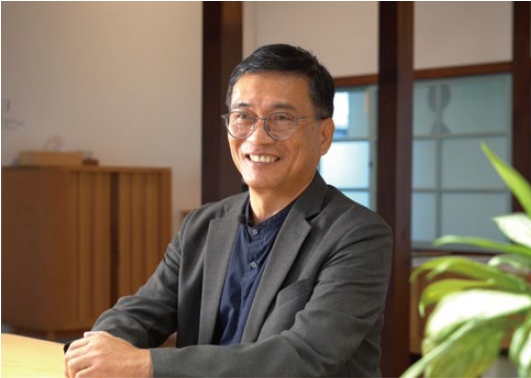Reflections on Wood Art in Daxi by Way of the Daxi Furniture Design Competition
Chin-Chieh, Huang / Founder, Brilliance of Wood Ltd.
"Reflections on Wood Art in Daxi by Way of the Daxi Furniture Design Competition"
In 1997, I received an invitation from the National Taiwan Craft Research and Development Institute to take part in a program to improve craftsmanship skills in Daxi’s Furniture Old Street. The experience has stayed with me since, and I’ve harbored a hope that Daxi’s furniture industry could continue to thrive and eventually become a world-class hub for furniture-making and design. This is a delightful mountain town with a rich wood crafting tradition and cultural legacy. This year’s The First Daxi International Wood Furniture Craft and Design Competition, organized by the Daxi Wood Art Ecomuseum, has been a long-awaited and widely-anticipated event. The aim of the competition is to facilitate exchange and learning between local Daxi wood artists and newcomers from around the world. It promises a fresh opportunity to revive the woodworking industry, a cultural specialty of Daxi. New ideas as well as innovative craft applications could arise from these exchange activities, leading to better crafts and new product designs robust in form and functionality.
I was honored to serve as a judge for the competition’s youth division. Several submissions boasted good ideas and creative thinking, so I shifted my evaluation focus to whether the design ideas can be translated into finished products. Furniture pieces are not about chairs and cabinets: they also include other pieces important to our lifestyles, so the overall structural factors, such as safety, must also be considered. The steps involved in creating a product must be rigorously understood, and the knowledge applied and practiced. So my advice for entrants is to focus on the details when designing furniture, and to showcase their personal aesthetic in a refined way. Furniture-making comes with a responsibility: an aesthetically-pleasing piece is hardly enough. It must also be structurally sound. I myself broke a chair just by sitting on it during evaluation, which really drove home the fact that instructors must guide students to think about functionality and structure at the start of the creative process—particularly when designing a chair! Designers and craftspeople are responsible for their work, which is why designs should be considered a social responsibility. Details are important, particularly for furniture and lifestyle products. This includes meticulous thinking about the paint, the structure, and material choices for your work.
As for the submissions, I think the youth division’s gold medal winner “Gradient” is a wonderfully balanced piece with an appealing feel, but unfortunately, the cutting technique and overall refinement of the piece still leave some room for improvement. Of course, the entrant is likely still a student given that this is the youth division, so I can understand the flaws, particularly given the state of vocational education in Taiwan. We on the judging panel are meticulous in assessing these works, and often in competitions, I see submissions created by entrants who display a skill level of a second-year student, at best, in my time—but it turns out that the entrants have already graduated from vocational school. Why is this? Because the craftspeople are not trying to improve their workmanship. There is no such thing as “best” in crafting, only “better.” How can we nurture more craftspeople and designers with this kind of lackluster dedication? My greatest wish is that this kind of international competition can continue in the future.
By looking beyond our borders, we can discover and rectify our flaws. That is how we can further develop wood crafting as a specialty in Daxi. I also hope that this competition could become a headlining event. The important thing is not the production or exhibition of the works, but the consideration of how the works acknowledge Daxi’s tradition from the start of the design process. We want Daxi’s craftspeople to work together and create designs that could be mass produced into marketable, lucrative products, not just single works of art. We need to rediscover this kind of Daxi spirit starting from the youth division.
I also had the chance to chat with master craftsman Li-hai Yiu about the competition, and he lamented that the submissions were overwhelmingly channeling the style of Nordic furniture. He wished that there were more designs inspired by Eastern culture, with a distinct path and design integrity. Many years ago, when I gave a lecture at Guangdong University of Technology’s School of Art and Design, the institute’s dean Fang Hai told me about a comment his advisor Yrjö Kukkapuro made to him when he was working on his PhD in Finland: “Why do you Easterners come to Scandinavia to study furniture design, when all we do is adapt and evolve the essence of furniture making from your culture? Why don’t you adopt those elements from your own ancestral culture into your own pieces?” Hearing this was very discomfiting, so I told Professor Fang that we should work together: he could promote Chinese-style furniture in China, and I could do the same in Taiwan! Since then, I would always integrate the German thinking that I learned and taught at St. Joseph Technical High School with the Chinese and Taiwan flairs that I admired and embraced in the past decades. Whether from Tainan, Daxi, or Lukang, I would strive to incorporate these elements into my designs. We should not just copy Nordic styles: rather, we could simply integrate some of the daily lifestyle experiences into these pieces. The style is lost if we overcomplicate things. We could look to Scandinavia for inspiration on borrowing Chinese furniture design substances and apply them to Daxi’s furniture-making. We could then grab what we need in our own culture, and begin thinking about creating Taiwan-appropriate pieces.
My hope for this competition is that it could drive the development of the industry in Daxi. Professional wood craftsmen nowadays tend to overlook the human and experience element, as the cultural climate has changed and information is readily available. When it comes to skill, experience is priceless. If we investigate in-depth a craftsman’s skill and training, we could clearly identify whether he or she works with his or her hands, sharpen their mental acuity, convey their intent, and apply these insights into their craft. This kind of craftsman can, through long and difficult training, become proficient in working with their materials. However, with master-apprentice systems in decline, any woodworking skill of depth can only be passed on through a combination of scientific theory and technical experience, bringing the learner up to speed within a short time. But these mentoring conditions offer little in the way of understanding and mastering the quality of the material, which result in poor production methods. That is why a pursuit of deep knowledge and understanding is essential for modern professional craftsmen.
Here, I have three suggestions to give:
1. Balance mechanical and hand production; integrate professional skillsets for longevity.
In this age of advanced technology, many manufacturing processes can be mechanized. For example, hand-fed and surface planers have replaced manually-prepped materials, which was time-consuming. The appropriate use of machinery could greatly improve efficiency, so even though the emotional resonance of handcrafting is essential in traditional woodworking, the changing environment means that machines must be adopted for many processes to achieve efficiency. However, adding handcrafting techniques where it is appropriate to the manufacturing process is also a good way to add character and style to the piece, an embodiment of a true professional. In a globalized world, the rapid dissemination of information means that no woodworking technique could be confined to a small group anymore. However, there remain different levels of refinement. If local industries cannot incorporate a wide range of practitioners and divide labor effectively, they will not stay competitive, let alone break away from their past limitations. That being said, I encourage craftspeople and artisans to break their preconceived notions and make as many connections as they can. Step out of your comfort zones and find kindred spirits with whom you could partner. Only then can the industry sustain itself.
2. Collect and use information smartly to improve quality; translate what’s traditional into what’s modern.
In an age where local cultures co-exist with a global information environment, we must understand that collecting, analyzing, and organizing information is an essential skill and something that must be practiced every day. Intelligently applying information is an important step in creative and design work, and a good way to improve the quality of your piece. Revitalizing traditional and historical elements in the context of modern life experiences, work, and creations, creating personal taste through appeals to sentiment, is the way to kickstart more creativity.
3. Create your signature style through innovation, sophistication, and quality; adapt to globalization by being prepared, adaptable, and humble.
Competition is fierce in Taiwan’s commercial market, and crudely-made work cannot survive in any market economy. So modern professionals should go beyond mass production methods, and focus on boutique-style manufacturing, yet innovation-driven SOPs. Craft your signature style by constantly refining your techniques and braving a high degree of customization. Be prepared and plan your work so that you do not rush or procrastinate. As a professional, you must always adapt and conquer. Do not think of your role as only an OEM producer; make it your goal to create the best work you can. Adaptability is the way to survive in uncertain processes and market competition. An old adage goes that if you understand one thing in-depth, you will be able to understand anything. Be bold and detail-oriented when you adapt. Finally, humility is the key for any professional for self-improvement. In a craft with endless depths, any professional must understand that there would always be someone better. You must be humble in order to carve out a space for yourself. The key is all in your mind and thinking.
I sincerely hope that modern craftspeople in Daxi can upgrade their art with sophisticated techniques and a scientific perspective. I hope artisans and designers can put their design thinking into practice, so that their work can give form to their intent, helping the woodcraft industry in Daxi reach new heights, and sustain the town’s legacy.

▶ This article is included in "The First Daxi International Wood Furniture Craft and Design Competition Exhibition Journal". We warmly invite you to purchase for further reading.
▶ Copyright and Licensing Statement:
All content published on this website—including but not limited to text descriptions, images, software, audio recordings, videos, and other information—is protected under copyright law. Without prior authorization, no part or whole of the website's content may be reproduced, publicly broadcast, publicly screened, publicly performed, publicly transmitted, or adapted in any manner governed by current copyright legislation. However, actions that constitute fair use under applicable copyright law are not subject to these restrictions.

